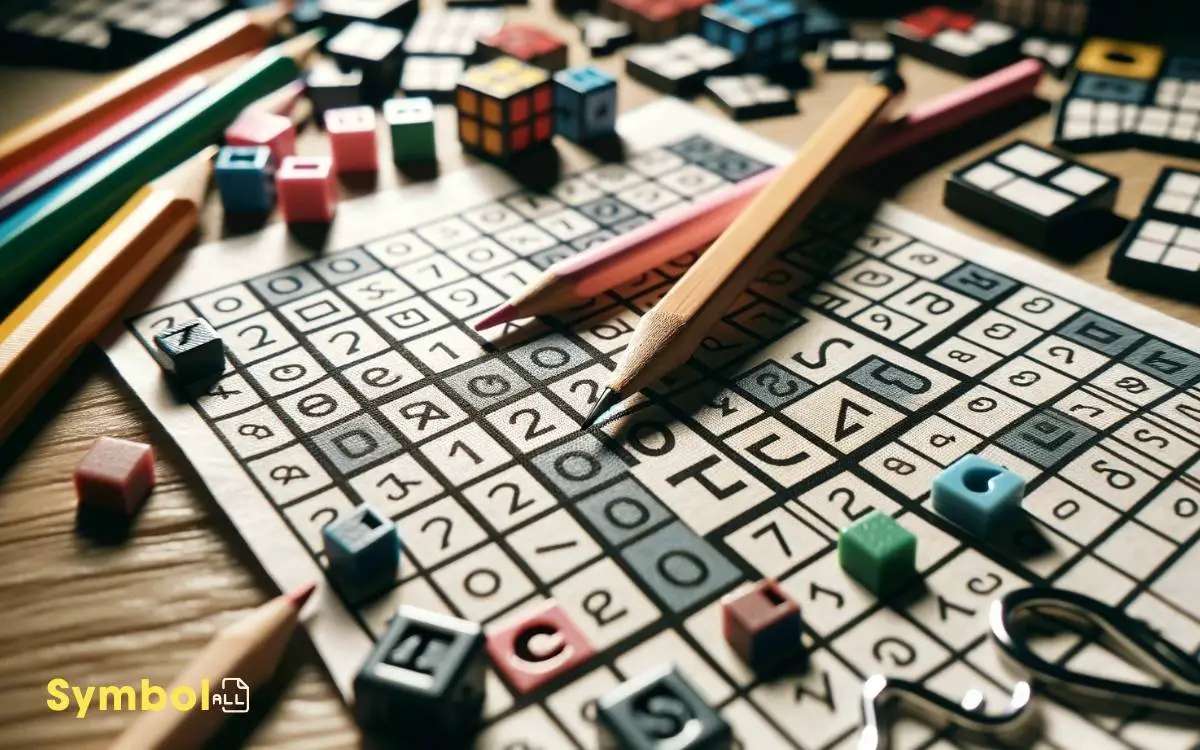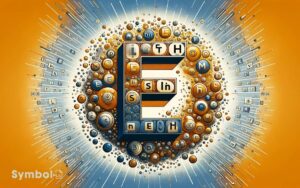Which Symbol Is Used in a Logic Puzzle Grid? X and O!
In logic puzzles, you’ll often encounter a variety of symbols, but X and O are particularly pivotal. They act as straightforward indicators; an X typically represents a false statement or a negative condition, simplifying your decision-making process by eliminating options.
Conversely, an O denotes a true statement or positive condition, guiding you towards the correct path. These symbols allow you to focus on logic and strategy, turning complex puzzles into manageable, binary decisions.
Understanding how to use these symbols effectively enhances your problem-solving skills and cognitive function. By grasping their significance, you unlock deeper insights into puzzle strategies.

Key Takeaways
Understanding Logic Puzzles
Why do logic puzzles captivate minds, you may wonder, as we delve into understanding their structure and appeal?
These puzzles engage your reasoning skills, requiring you to deduce relationships or patterns from a set of clues.
They’re not just about finding the right answer; they’re about the process of logical deduction. This process stimulates your brain, enhancing cognitive functions and problem-solving skills.
Logic puzzles come in various forms, each with its unique challenge. Whether it’s a grid-based puzzle, a sequence puzzle, or a word-based problem, the core principle remains the same: to apply logic to solve.
They demand attention to detail and the ability to hold multiple pieces of information in mind simultaneously.
It’s this mental juggling act that makes solving them so rewarding.
The Role of Symbols
In logic puzzles, symbols serve as crucial tools that simplify complex relationships and patterns, making them easier for you to decipher. These symbols are the language of logic puzzles, translating intricate ideas into a form that’s digestible at a glance.
They’re not just placeholders; each one has a specific function, guiding you through the puzzle’s logic in a step-by-step manner. This systematic approach enables you to focus on strategy rather than getting bogged down by details.
Common Symbols Explained
Building on the foundational role of symbols in logic puzzles, let’s explore the common symbols you’ll encounter and their specific functions. Symbols like arrows, squares, circles, and lines are essential tools for conveying relationships and operations without the clutter of words.
Arrows often indicate direction or flow, mapping the path from one element to another, illustrating a sequence or hierarchy.
Squares and circles can denote categories, with squares typically representing one set of items and circles another, facilitating quick visual differentiation. Lines, whether solid or dashed, connect elements to show association or separation.
Understanding these symbols allows you to grasp the puzzle’s logic at a glance, making your problem-solving process more efficient and effective. Each symbol serves a distinct purpose, guiding you through the puzzle’s narrative without ambiguity.
The X and O Notation
You’ll find that grasping the X and O notation is fundamental to navigating logic puzzles effectively.
Their application in puzzles not only structures the challenge but also dictates specific strategies for solving.
Understanding X and O
Understanding the X and O notation is crucial for solving logic puzzles, as these symbols play a pivotal role in denoting specific conditions or outcomes. In essence, the X often represents a negative condition or a false statement, effectively saying ‘this possibility is eliminated.’
On the other hand, the O symbol usually signifies a positive condition or a true statement, indicating ‘this option is correct’ or ‘these elements are connected.’
Recognizing this distinction allows you to navigate through puzzles with greater ease, applying logic to deduce the correct arrangement of elements or the solution to a problem.
It’s a simple yet powerful tool in your puzzle-solving arsenal, transforming seemingly complex grids into solvable challenges through systematic elimination and selection.
Application in Puzzles
Having grasped the significance of X and O in logic puzzles, let’s explore how they’re applied to solve these challenges effectively.
The X and O notation serves as a fundamental tool, allowing puzzle solvers to visually organize information and deduce relationships between elements within the puzzle.
| Symbol | Application |
|---|---|
| X | Indicates a false or negative relationship between elements. |
| O | Represents a true or positive connection. |
| X | Used to eliminate possibilities, narrowing down the options. |
| O | Helps identify correct answers or relationships, guiding towards the solution. |
This binary system simplifies complex puzzles by breaking them down into a series of simpler, binary decisions, making the puzzle-solving process more systematic and less prone to error.
Strategies for Solving
How can the X and O notation enhance your strategy when tackling logic puzzles?
Understanding this notation system is key to efficiently solving puzzles. The ‘O’ often represents a correct answer or a match, while ‘X’ denotes incorrect options or mismatches.
This binary system simplifies complex information, making it easier to visualize patterns and relationships between elements. By systematically filling in Xs and Os, you eliminate possibilities, narrowing down to the right solution.
It’s a process of deduction; each X and O placed informs your next move, reducing guesswork. Furthermore, this method encourages a structured approach, prompting you to consider all possibilities before making a decision.
Mastering the X and O notation not only improves your puzzle-solving efficiency but also enhances your logical thinking skills.
Importance of the X Symbol
In logic puzzles, the X symbol plays a critical role, as it often marks the intersection of crucial clues or the elimination of certain possibilities. This simplifies your puzzle-solving process by clearly showing what can’t be true, thus narrowing down the options for what must be true.
| Use Case | Benefit |
|---|---|
| Eliminating Options | Focuses your search |
| Marking Intersections | Identifies key clues |
| Clarifying Relationships | Streamlines thought process |
| Visual Simplification | Reduces cognitive load |
| Tracking Progress | Provides a sense of accomplishment |
The X symbol’s utility can’t be overstated. It’s not just a mark; it’s a tool that significantly enhances your analytical capabilities within the puzzle.
By effectively using this symbol, you’re not just crossing out impossibilities; you’re uncovering the path to the solution more efficiently.
How to Use Symbols Effectively
To effectively leverage symbols in logic puzzles, you’ll need to understand their specific functions and applications. Symbols act as shorthand, enabling quicker reasoning and solution.
Here’s how to use them effectively:
- Identify Patterns: Recognize how symbols relate to each other within the puzzle’s context. This may involve sequences, pairings, or hierarchies.
- Deduce Relationships: Use symbols to infer connections between elements. For instance, if a symbol indicates a direct relationship, analyze how that impacts surrounding elements.
- Apply Consistently: Ensure that once you assign a meaning to a symbol, you apply it uniformly throughout the puzzle. Consistency is key to avoiding confusion and ensuring that your logic remains solid.
Understanding these aspects allows you to navigate puzzles more adeptly, transforming symbols from mere markings to powerful tools in your problem-solving arsenal.
Tips for Logic Puzzle Grids
Why not elevate your logic puzzle-solving skills by mastering the art of using grid techniques effectively? Start by ensuring you fully understand the clues before marking the grid. Misinterpretation leads to mistakes.
It’s crucial to approach the puzzle systematically; begin with the most straightforward clues to gain momentum and gradually tackle more complex ones. This method helps in establishing a solid foundation, making it easier to deduce the remaining answers.
Additionally, keep the grid clean and organized. Avoid clutter by using simple, consistent symbols or color coding to differentiate between confirmed and potential matches.
Enhancing Your Puzzle Strategy
Building on the foundation of basic grid techniques, let’s explore advanced strategies to further enhance your puzzle-solving prowess. Beyond the initial steps, mastering a few key strategies can significantly improve your efficiency and success rate.
Here are three pivotal tactics:
- Cross-Referencing: Cross-reference clues across different categories to eliminate impossibilities, tightening the range of potential answers.
- Pattern Recognition: Identify patterns or sequences within the puzzle. This can often lead to quicker eliminations or confirmations of certain elements.
- Hypothesis Testing: Temporarily assume a solution for one variable. Analyze the implications. If contradictions arise, discard that assumption; this method often uncovers hidden relationships or valid solutions.
Incorporating these techniques into your strategy ensures a more analytical and structured approach, ultimately leading to a higher success rate in solving logic puzzles.
Conclusion
In wrapping up, you’ve ventured through the maze of logic puzzles, where symbols like X and O aren’t just letters but keys to unlocking mysteries. Remember, the X isn’t just a mark; it’s your beacon in the puzzle sea.
Use these symbols not as mere scribbles but as strategic allies. With these tips, your journey through logic puzzles becomes not just a test of wits but a dance of intellect.
Embrace these symbols, and watch your puzzle-solving prowess flourish.





